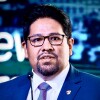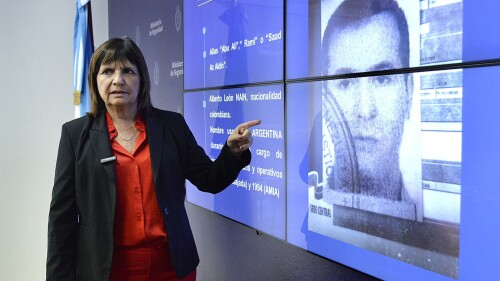U.S. Secretary of State Rex Tillerson just completed, by most accounts, a successful visit to Latin America. He began his five-nation tour by invoking the Monroe Doctrine and suggesting the Venezuelan military could manage a “peaceful transition” from the authoritarian leader Nicolás Maduro. This reminded several regional observers of President Trump’s suggestion last year of a possible “military option” for Venezuela, hinting at possible U.S. or multilateral intervention to stop the country’s collapse.
Any party in the Western Hemisphere seeking to undertake military intervention in Venezuela— including Venezuela’s own military—must take into account the role Iran, Russia and China have played in the crisis. Russia and China were prominently mentioned by Tillerson during his visit to the region; Iran, however, was notably absent from his remarks.
Most regional analysts will likely agree that Venezuela has become a Cuban-occupied country. With more than 30,000 Cubans embedded in Venezuela, many of whom are part of the intelligence and security apparatus, it’s clear that the Castro brothers played an integral role in the country’s collapse. However, this narrative of Cuban intervention misses two key points. First, it fails to identify precisely Cuba’s role in Venezuela, and, secondly, it ignores the presence and influence of other key extra-regional actors.
External support from China, Russia, and Cuba has contributed significantly to propping up the Venezuelan government during the last decade. |
Of these, Russia and China are perhaps the two most visible. As in Syria, and, historically, in Central America, Russia is the primary supplier of military aidand technical support to the Venezuelan armed forces. Venezuela represents 75% of Russia’s total foreign military sales in the region, accounting for more than$11 billion in arms sales. Additionally, the Russian state-owned energy firm, Rosneft, has provided Venezuela with an estimated $17 billion in financing since 2006. Moscow has leveraged its collateral deals to acquire expanded stakes in Venezuela’s oilfields—specifically, the heavy-crude Orinoco belt—providing Russia greater control of Venezuela’s strategic energy assets.
Russia is not alone in translating Venezuelan debt into strategic assets. According to the International Institute of Finance, China holds more than $23 billion in Venezuela’s foreign debt, making it the country’s largest creditor. Through these credits and loans, Beijing is the primary benefactor and principal banker to the South American nation, yielding enormous leverage over the state.
Chinese energy companies are also gaining an increasing share of Venezuela’s most lucrative oil field, the Faja Del Orinoco (FDO). China secured a 25-year land grant to the FDO. In exchange, China has used its checkbook to fund many of the nation’s social programs, such as subsidized housing and free medical clinics.
Pictured: Venezuelan President Nicolás Maduro visits Iran’s Supreme Leader, Ayatollah Ali Khamenei, in Iran on October 22, 2016. |
External support from China, Russia, and Cuba has buoyed the Venezuelan government during the last decade. Cuba’s robust counterintelligence and human intelligence networks, which permeate Venezuela’s highest political and military levels, are indispensable to China and Russia because of their operational knowledge of Russian-supplied equipment, along with their longstanding ties to communist clandestine networks. In this context, it is hard to imagine a strategy that would remove Havana’s presence from Venezuela without first passing through Moscow or Beijing. Iran, on the other hand, can operate independently in Venezuela because it taps into a separate, more robust clandestine network that has been developing in Latin America for more than half a century.
Approximately 60% of the population of the city of As-Suwayda in southwestern Syria (pop. 139,000, according to the 2004 census) are Venezuelan-born dual citizens. Many more have arrived since 2009. The district of As-Suwayda (same name as the city) has been dubbed “Little Venezuela.” Estimates indicate that upwards of 300,000 Syrians from the As-Suwayda Governorate currently live halfway around the world in Venezuela. According to the late Venezuelan President Hugo Chávez, more than a million Syrians reside there. This Syria-Venezuela connection could represent a clandestine network managed by Iran and critical to the advancement of Chavez’s “Bolivarian revolution.”
As in the Syria conflict, Iran’s primarily role is preparing the Venezuelan battlefield through a range of operations in irregular warfare, using non-state actors and surrogates to gain influence over the population. Its influence is often not visible on the ground, but it was evident when Iranian-trained forces helped repress anti-regime protestors in 2017. During anti-Maduro demonstrations, the motorcycle-riding members of the Venezuelan civilian militias known as Collectivos were clearly modeled on and trained by Iran’s paramilitary Basij militia. The role of the Basij in crushing Iran’s Green Revolution in 2009 provided lesson for dealing with anti-regime protestors half a decade later in Venezuela.
Strong evidence suggests that Venezuela used its immigration agency (SAIME) to provide Venezuelan identities and documents to several hundred, if not thousands, of Middle Easterners. |
The extent of Iran’s influence in Venezuela has long been a source of debate among U.S. and regional security analysts. In many ways, Iran has positioned itself in Venezuela to capitalize on China’s economic clout and Russia’s military footprint. For instance, Iran’s Ministry of Defense and Armed Forces Logistics (MODAFL) used a variety of joint projects with Venezuela’s military industry (CAVIM), as well as Russian and Chinese oil contracts with PDVSA, to shield it from international sanctions.
Iran’s most salient expertise, however, is in the development of clandestine structures through surrogate forces and proxy networks. Its most prominent proxy force, Lebanese Hezbollah, is known to deploy to global hotspots on behalf of Iran. Meanwhile, the Qods Force (the extra-territorial arm of Iran’s Islamic Revolutionary Guards Corps - IRGC) works with Hezbollah to increase social pressure in these hotspots to exacerbate conflicts. The Hezbollah and IRGC-QF cooperation is an important component of the Syrian civil war.
In Venezuela, long-standing clandestine networks from Syria, Lebanon and the Middle East are playing a similar role behind the scenes in shaping the narrative and ultimately directing the actions of the country’s key players. These networks have provided the Venezuelan regime with the know-how to control the population and propagate its narrative. Their influence is evident from the prominence of in the Venezuelan government.
Protesters have taken to Venezuela’s streets to condemn unprecedented levels of oppression. |
The humanitarian crisis in Venezuela began with severe shortages of food and medicine, prompting a a popular uprising last year. Syria faced a similarly severe drought before its civil war that contributed to the violent uprisings that began in 2011. As in Syria, Venezuela faces a humanitarian crisis that exacerbates refugee outflows with serious counterterrorism concerns and a strong Russian and Iranian presence. Unlike Syria, however, this crisis rests much closer to U.S. shores. Strong evidence suggests that Venezuela used its immigration agency (SAIME) to provide Venezuelan identities and documents to several hundred, if not thousands, of Middle Easterners. Unless our regional allies have proper vetting and verification measures in place, as well as a high degree of counterintelligence support, they will not know if the Venezuelan refugees spilling across their borders are legitimate refugees or members of a transregional clandestine network between Latin America and the Middle East.
As Secretary Tillerson calls upon regional allies to increase support to resolve Venezuela’s humanitarian crisis and apply more pressure to the Maduro regime, it would also make sense for the Trump administration to help U.S. allies by enhancing their counterintelligence and counterterrorism capabilities against Iran and Hezbollah in the Western Hemisphere. It appears that some of this cooperation is already beginning to take place, as evidenced by a new agreement between the U.S. and Argentina to tackle Hezbollah’s illicit financing in the Southern Cone.
Dealing with the tragedy that has transpired in Venezuela over more than two decades will require a better public understanding of the central role of extra-regional actors, particularly Iran, in the country’s crisis.
Any intervention in Venezuela -- military, humanitarian or otherwise -- will not work unless it is aimed at removing the external influences, especially Iran, Russia and China, that have turned Venezuela into the Syria of the Western Hemisphere.
Joseph M. Humire is the executive director of the Center for a Secure Free Society (SFS) and a fellow at the Middle East Forum. This article has taken excerpts from a forthcoming special report by Mr. Humire on “Venezuela’s Crisis: A New Global Paradigm.” You can follow him on Twitter at: @jmhumire.










